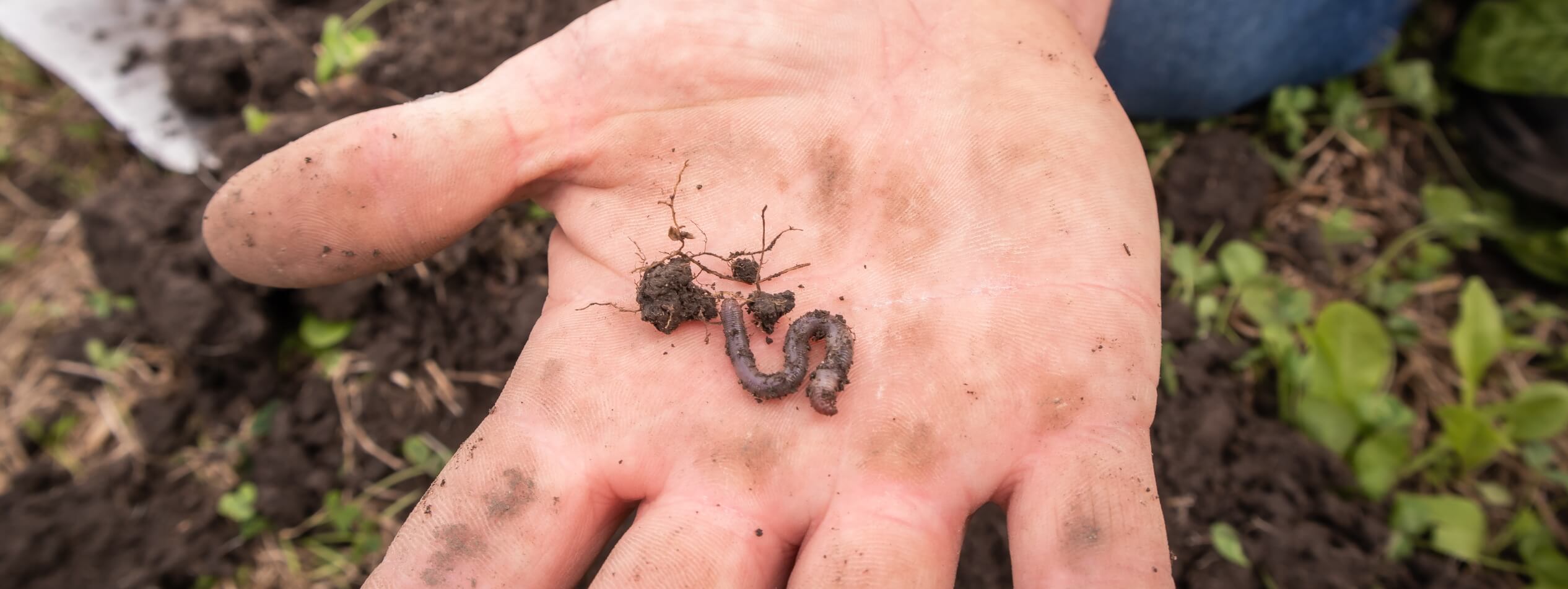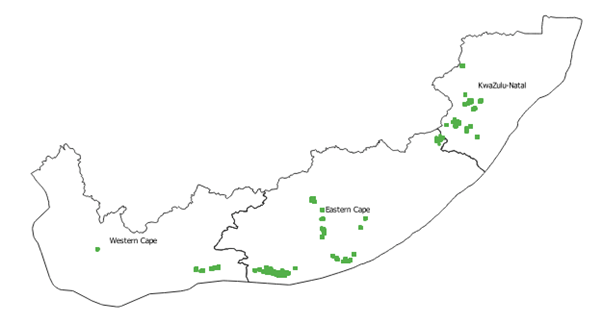Goal of case study
We have a huge database of soil results from many pasture-based dairy farms throughout the coastal region of South Africa. I thought it interesting to have a look at some of the broad-scale trends that can be seen from this database. The goal of this is just to see what some of the soil results look like in an aggregated form. This will allow any interested party to see what the trends are, and it will allow farmers to check their own results and see where they are positioned compared to other farmers.
This data will also allow us to identify where the greatest opportunities for improvement are across these farms.
Dataset
The dataset for the case study comprises of 95 farms with soil samples taken in either 2020 or 2021, whichever are the most recent samples. 79 farms had samples taken in 2021, with the other 16 having their most recent samples in 2020. These 95 farms have an average area of 442 hectares, therefore a total area of 41 971 hectares is represented by this case study. There are 5874 unique soil samples included. The map below shows the locations of all these soil samples across the Western Cape, Eastern Cape and KZN.
Soil parameters
Trace & Save uses various indicators of the three legs of soil health (life, fertility and structure) to understand the health of a soil. Table 1 below lays out some of what we analyse, which leg of soil health it relates to and what the relevance is to soil health. This is not an exhaustive list, but rather only what was included in this case study. I left out some of the life analyses, the micro-nutrients, and some structure indicators. Including them would have made the case study far too long.
Table 1
Descriptive statistics
Firstly, to get an idea of what the average and range of values looks like across these farms, I have included Table 2 of descriptive statistics below.
Table 2
It is quite fascinating that if you just look at the average results there are ideal soil carbon, active carbon, total nitrogen, phosphorous, potassium, sodium, and magnesium levels. The pH is slightly low, the calcium base saturation is low although the concentration of calcium is at ideal levels, and the sulphur levels are high. All of this said, there is a huge amount of variability in this data. The standard deviation gives you an idea of this variability. For example, the total nitrogen standard deviation is almost as high as the average. The higher the standard deviation, the less consistent the data.
There is also a huge range in results when you look at the maximum and minimum values. For example, the highest total carbon result is 12.2%, which is very high, along with the highest active carbon of 1 579 mg/kg. Both are well above ideal levels. On the other hand, the lowest total carbon value is 0.3% and the lowest active carbon value is 0. These are very, very low values. The same is true for all the results.
Analysis
I looked at how many camps there are where 80% or more of the parameters are at an ideal level, i.e. 8 or more parameters. This are camps we can say have good health. And at how many camps there are where there are more than 50% of the parameters at an ideal level, i.e. more than 5 parameters. These are camps we can say have moderate health. This will give an indication of what the overall health of the soils are that we are working with on pasture-based dairy farms.
I further looked at each parameter above for each camp in the dataset and determined whether the result was within ideal levels or not. So for all 10 parameters there is a determination of how many of the camps are ideal, how many are deficient and how many are excessive. I also used a Pearson correlation test to see what the relationships are between these 10 parameters.
Ideal camps for each parameter
Table 3 shows the results of the analysis which looked at what proportion of the camps in the dataset have ideal levels or not for each parameter.
From a soil life perspective it is encouraging to see that most camps have ideal total carbon, active carbon, and total nitrogen levels. This shows that there is sufficient organic material in the soil. It is not surprising, since one of the big advantages of pastures is that they add large amounts of organic material to the soil through their dense root structures and high photosynthetic rate (Photosynthesis – the true source of soil carbon). All three parameters are positively correlated to each other. What is concerning though is that ≈ 35% proportion of camps carbon is deficient, whereas nitrogen is excessive. This points to an imbalance in the carbon:nitrogen ratio in the soil (Does your soil have a balanced diet?). This is also not surprising since there is a large amount of excessive nitrogen entering dairy farms every year (How we are wasting money and nutrients, and negatively impacting the environment).
Table 3
From a fertility perspective there are obvious issues with pH being to low, and deficiencies in potassium, and calcium. The low pH and calcium deficiency are directly linked, as optimal calcium levels are associated with ideal pH levels. There are also very low inherent pH levels in many of the areas we work in (i.e. the Tsitsikamma and KZN). Based on what we have observed on the farms we have worked with over the past eight years, we have seen huge improvements in calcium levels where liming has been prioritised. In the Tsitsikamma this has led to associated increases in pH. We have been working for a shorter period in KZN (three years), so we have not seen as clear trends. Deficient potassium levels are a problem in many regions and is shown by this data that it is probably the greatest challenge with regards to soil fertility. There is a strong positive correlation between total carbon and potassium (r = 0.367; p < 0.001). It is the strongest relationship between carbon and any of the nutrients in the soil. This shows that the best opportunity for farmers to address deficient potassium is to increase carbon levels. Since carbon is also positively correlated with calcium (r = 0.268, p < 0.001) it will also help in that regard.
Magnesium, and to a lesser extent sulphur, are the only two nutrients where the most common result is excessive levels. This is linked to the excessive nutrients brought onto dairy farms. Magnesium is problematic because it is not easily leached from the soil and therefore builds up to a greater extent. It is a challenge because there is not an easy solution to excessive soil magnesium levels. Farmers therefore need to focus on improving nutrient use efficiencies and reducing excess nutrients brought onto the farm, as this is the most viable long-term solution. Sulphur, on the other hand, is highly leachable. We often see large fluctuations in sulphur levels on farms year-to-year. The cause is the same as magnesium, excessive importing of nutrients, but it is not as problematic. The one thing that should be pointed out with sulphur is that it is negatively correlated with pH (r = -0.137; p < 0.001). Since low pH levels are a problem, this relationship is important to note.
Most of the camps phosphorous and sodium levels are ideal. Excessive sodium is more of a problem than deficient levels, and this should be closely monitored on farms with high sodium. An additional challenge on many farms is that the irrigation water has high sodium levels. Interestingly with phosphorous there are slightly more camps with excessive phosphorous than with deficient levels. Deficient phosphorous is an obvious problem but can be easily addressed with appropriate fertiliser additions. Excessive phosphorous on the other hand is a challenge, very similarly to magnesium, with the same cause. From a fertiliser strategy perspective it is important to note that a very small percentage of camps require phosphorous fertiliser. There are still far too many farmers who apply phosphorous, irrespective of their soil results, especially at planting. Not only is this a waste of money, but excessive phosphorous enters our water systems and becomes a major environmental problem.
Soil health status of camps
When looking at the overall soil health status of camps, Table 4 shows the distribution of camps with good, moderate, and poor overall health.
Table 4
To reiterate, camps with good overall soil health are those which had ideal levels for 80% or more parameters, and camps with moderate health are those which had ideal levels for more than half of the parameters. There are very few camps with good soil health, and most of the camps have poor health. This means that there is still great opportunity for improvement on all the farms we work on.
Conclusion
Some of these results are encouraging and others show the extent of the challenge which still exists on pasture-based dairy farms. The majority of camps do not have optimal soil health. This should not discourage farmers, but rather give them renewed energy to focus on the practices which can improve the health of their soils.
- A carbon footprint assessment for pasture-based dairy farming systems in South Africa - 2024-02-07
- What progress have farms participating with Trace & Save made over the past 10 years? - 2023-09-06
- Carbon footprint reduction over time: Lessons from pasture-based dairy farms in South Africa - 2023-09-04






